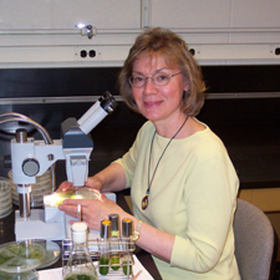

1445 Gortner Avenue
St. Paul, MN 55108
United States
Carolyn
Silflow
I study genes involved in replication, segregation, and localization of basal bodies in Chlamydomonas.
We study genes involved in replication, segregation, and localization of basal bodies in Chlamydomonas. Basal bodies (centrioles) are cylindrical organelles with walls composed of nine sets of triplet microtubules. The triplet microtubules provide templates for assembly of doublet microtubules during the growth of cilia and flagella in eukaryotic cells. We are interested in the molecular mechanisms necessary for replication, segregation, and positioning of basal bodies/centrioles as well as in the pathway by which a basal body acquires competence for assembly of a flagellum.
Chlamydomonascells have two anterior flagella (cilia), which grow from basal bodies found beneath the plasma membrane. The basal bodies are duplicated and segregated to daughter cells in a semi-conservative manner so that each cell contains basal bodies of different “ages”. In Chlamydomonas, the older basal body is positioned on the opposite side of the cell (trans) to the eyespot while the younger basal body lies on the same side of the cell (cis) to the eyespot (Holmes and Dutcher, J. Cell Sci. 94:273). In wild-type cells, both the cis and trans basal bodies assemble flagella.
We are studying mutations in the UNI1 and UNI2 genes that result in cell populations with 0, 1, or 2 flagella. The single flagellum on uniflagellate cells assembles on the older of the two basal bodies, indicating that the defect in uni1 and uni2 mutant cells is a delay in the maturation pathway. Insight into this pathway came from our ultrastructural studies of the basal bodies in mutant cells when we found that the inability to assemble a flagellum is correlated with incomplete transition of triplet microtubules to doublet microtubules at the distal end of the basal body. The Uni2 protein localizes to probasal bodies and to the distal end of basal bodies where it likely plays a role in the microtubule transition. Currently we are studying the localization and function of the Uni1 protein.
In another project, we are using Chlamydomonas in a genetic approach to understand the action of antimicrotubule herbicides. Higher plant cells and Chlamydomonas cells are exquisitely sensitive to pre-emergent herbicides in the dinitroaniline and phosphoric amide classes that disrupt microtubule assembly and cell division in seedlings. We selected for mutant Chlamydomonas strains that are resistant to the effects of the herbicides. Unexpectedly, most of the mutations did not reside in genes encoding tubulins, the proteins from which microtubules are assembled. We have cloned the genes identified by the apm1 and apm2 mutations and found that they encode cytosolic chaperone proteins hsp40 and hsp70, respectively. These proteins may be involved in folding a target protein that destabilizes microtubules. When the function of these chaperone proteins is lost in the mutant cells, the microtubules become more stable and thus are resistant to the anti-microtubule herbicide. We are interested in identifying the target(s) protein. Another focus is to clone genes identified by other mutations that result in resistance to these herbicides.
I am co-director of the Chlamydomonas Resource Center, an NSF-supported center for the maintenance and distribution of Chlamydomonas strains and other research materials. Please see the website at https://www.chlamycollection.org/
Piaseck, B.P., M. LaVoie, L.-W. Tam, and P.A. Lefebvre. 2007. The Uni2 phosphoprotein is a cell cycle-regulated component of the basal body maturation pathway in Chlamydomonas reinhardtii. Mol. Biol. Cell 19:262-273.
Piasecki B.P. and C.D. Silflow. 2009. The UNI1 and UNI2 genes function in the transition of triplet to doublet microtubules between the centriole and cilim in Chlamydomonas. Mol. Biol. Cell 20:368-378.
Silflow, C.D., X.Sun, N. A. Haas, J.W. Foley, and P.A. Lefebvre. 2011. The Hsp70 and Hsp40 chaperones influence microtubule stability in Chlamydomonas. Genetics 189:1249-1260.
- Cloning genes tagged by insertional mutagenesis in Chlamydomonas
- Genetic analysis of mutations in Chlamydomonas
- Immunofluorescence localization of proteins in cells
- Ultrastructural analysis of the basal body apparatus in Chlamydomonas cells
- Mapping molecular markers on the Chlamydomonas nuclear genome